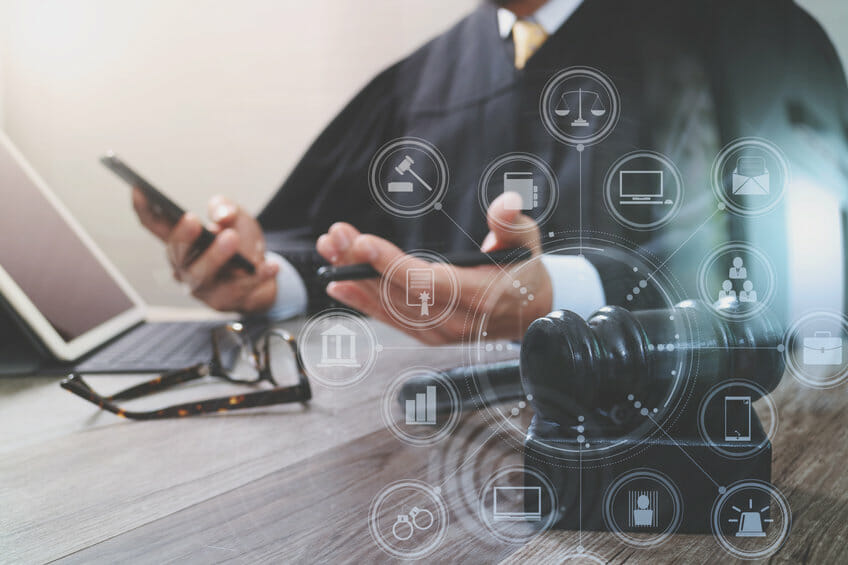When the Maricopa County Justice Courts went virtual at the beginning of the pandemic, many attorneys and judges were doubtful of the system. Now the use of technology has allowed the courts to continue operating.
The Covid 19 pandemic forced many businesses and government offices to work remotely. As a result, this year and a half has been a constant trial and error for the Maricopa County Justice Courts to figure out which virtual system works best.
Nowadays, it’s possible to have empty courtrooms. People all over Phoenix can attend virtually, either by phone or video. Litigants can appear remotely and comply with the court. Before the pandemic, many weren’t able to show up.
“When you do not need to get in your car and drive to the court and then drive back home again it makes the process faster and easier and therefore more litigants appear. The impact of this is especially beneficial for litigants who live a distance from the courts location.” said Justice of the Peace Keith Russell, East Mesa Justice Court.
READ ALSO: Ranking Arizona: Top 10 law firms for 2021
This has been one of the most significant advantages for the Maricopa County Justice Courts as the system has been adapted to become more consumer-friendly.
“It allows flexibility and ease in scheduling future court dates working around work, school or other obligations.” said Justice of the Peace Anna Huberman, of the Country Meadows Justice Court
Nevertheless, Justice Courts officials said not all hearings will go virtual.
“We know that many people prefer to stand in front of the judge to make their case, so we will never see a system where all hearings are virtual. It is important that each litigant feel that they were able to participate in the most comfortable way,” said Scott Davis, the Public Information Officer for the Maricopa County Justice Court system.
While attending court virtually has been convenient for many defendants, and there has been a reduction of “people failing to appear,” some people need to be reminded that court protocols need to be followed.
“It is important to keep in mind that this is still a court of law and many formalities are still expected; be on time, read all information sent by the court, be polite and professional, “said Justice of the Peace Donald Watts, Manistee Justice Court
Challenges the Courts have faced with technology
According to court officials, one of the most common challenges is background noise.
“There have been children crying and doing homework in the background; pets, landscapers, and construction workers making noise on calls; callers arguing with others in their household while court is going on. One caller was swearing about her case,” said Davis
Even though the court hearings are entirely on phone or video, protocols still must be followed. “Now we have to tell each person to put their phone, tablet, or computer on “mute” until the judge calls their name. Only then should they unmute and speak to answer the judge’s questions,” said Davis.
Another problem the courts have faced with telephone hearings is body language. “Telephone hearings are difficult without seeing a person’s face or body language as they feel the need to speak. Callers’ attention may drift when it is not yet their turn,” said Davis
Scopia, telephone hearings, and video
Before the pandemic, the Maricopa County Justice Courts had a system called Scopia. According to Davis, this system enabled the courts to connect via touch screen controls. However, this system was only used when judges had previous commitments and could not attend in person.
“It was never used for court proceedings because the expectation was for the parties to appear in person and stand before the judge. That was not only tradition, but also the standard,” said Davis.
In March 2020 Justices of the Peace and Justice Court administration began to discuss how the court would adapt to the pandemic. “They used Scopia, Zoom, and GoToMeeting, the Zoom and GoToMeeting platforms were offered at no cost to the Justice Court because other divisions within Arizona’s judicial branch already had accounts that were available,” said Davis
The courts purchased webcams and, in some cases, new headsets to adapt to the new normal. “I do not have a dollar figure but I expect it to be well under $5,000,” said Davis
In the end, the courts decided to use Teams for all their internal meetings. This Microsoft platform allowed the courts to have document sharing and online meetings.
“We were already using all Microsoft products; the Superior Court in Maricopa County had started using a version of Teams to hold court. Now, all administrative and other internal meetings are held using Teams,” said Davis
On March 26 of 2021, the Superior Court said that all Justice Courts proceedings would be held by phone and not in person.
According to Davis, The Maricopa County Justice Courts adapted using Scopia for telephone hearings and assigned an access code to their 26 justice courts at no additional cost.
“It was easy for case participants to call in to the system and be seen by court staff who could “moderate” each call via Scopia software.”
When the court switched to phone and video systems, people appeared more in court than ever before. Failure to appear was at its lowest that it had ever been, especially in eviction cases.
“Pre-pandemic, the eviction FTA rate was about 35%. Now, it’s 15% and the legislature enacted a new law ensuring telephonic hearings will always be an option,” said Davis.
According to Davis, by the end of 2020, the Superior Court in Maricopa County was making inroads with video hearings via a system called “Court Connect.”
The Justice courts adapted this technology and were able to transition all 26 courts to be remote.
“It is important to note that the Superior Court orders requiring telephonic hearings have all expired, and most courts now are doing a mixture of in-person and remote proceedings with Court Connect. ”
Litigants can access the remote and virtual hearings through a notice sent by the court. These forms were modified to adapt to the new technology being used by the courts.
“Like the attached CC North Valley Notice. It has a QR code, web site, and call-in phone numbers listed for the parties to participate virtually,” said Davis
The courts have also added more information to its website, including COVID information and additional self-help packets.
“This includes court email addresses and additional “self-help” packets for all our various case types,” said Davis
How to plan for virtual hearings
People must still prepare ahead of time and get used to the virtual court system before being called for a hearing.
“A little bit of advance planning can go a long way in resolving legal issues,” said Watts
According to Davis, you should “Let the court know ahead of time if you want to appear virtually rather than in person. Also, let the court know if you need an interpreter.
Call the court directly if you have trouble accessing the virtual courtroom. Be respectful to the judge and others in court.”
The virtual hearings have allowed the court to be more consumer-friendly.
“Judges and court staff have adapted. Because the public has become so reliant on an online presence,” said Davis.
Technology isn’t going away anytime soon, and courts have discovered that people can benefit from this new approach to court hearings.
“In my opinion many case types can be properly managed through the use of technology, we may as well embrace it, it is here to stay,” said Watts
Nevertheless, according to Justice of the Peace Leonore Driggs of Arcadia-Biltmore Justice Court, “Justice really is blind when it is virtual.”




